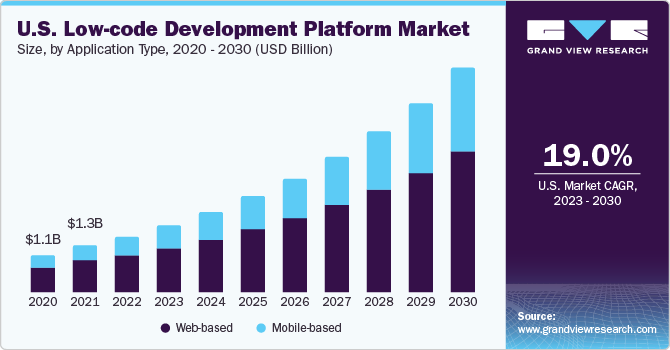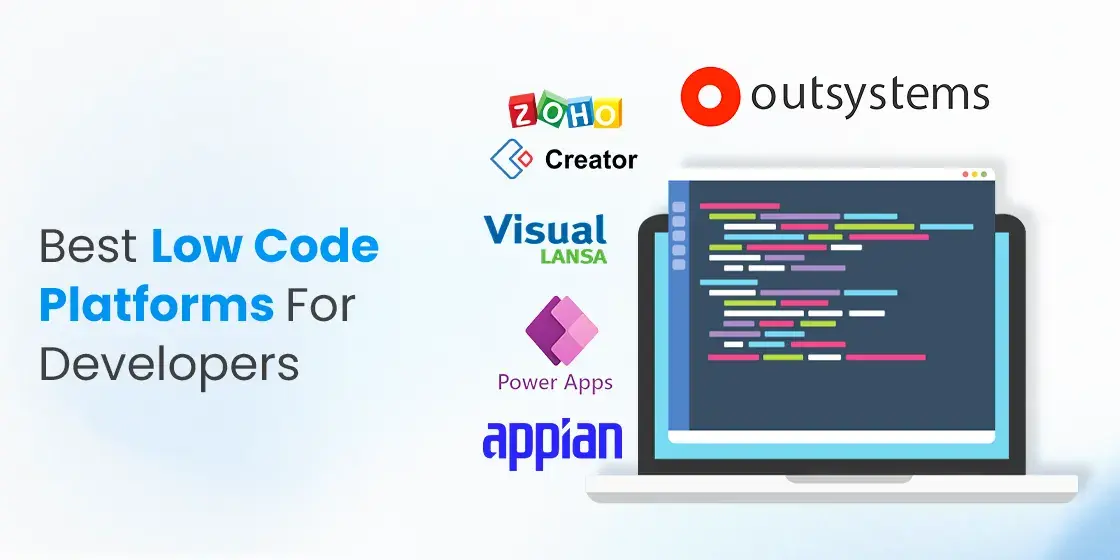Best Info For Deciding On Low-code platforms for application development
Best Info For Deciding On Low-code platforms for application development
Blog Article
Benefits Of Low-Code Development For Non-Developers In Terms Accessibility
The following main factors make low-code programming accessible to those who are not developers.
Drag-and-Drop Builders: Low-code platforms have drag-and drop interfaces that allow non-developers to develop applications without needing to write a single line of code. The process of developing applications is now more accessible for those who have no technical background.
WYSIWYG editor: The "What you see is the result you get" editors allow users to design interfaces, workflows and other functions in a manner that is similar to the final outcome. They are easier to comprehend and make use of.
Simplified Workflow Design and Logic Design
Visual Workflow modeling: Users can design business flows and application logic with visual flowcharts. The models are more intuitive to work with than traditional code methods.
Low-code platforms typically come with pre-built logic elements (e.g., conditions statements, loops) which eliminate the need for complicated programming.
Templates and components that can be reused:
Libraries of pre-built templates: A lot of low-code platforms offer an application library that can be used for the most common types of applications, providing those who are not developers a base that they can build upon and modify.
Reusable Widgets and Modules Users can leverage modular and reusable widgets which can be created faster, reducing the time needed to create them and reducing the need for in-depth technical knowledge.
Guided Development and Tutorials
Step-by-Step guides: Platforms provide tutorials and on-screen help to non-developers who are building applications.
Interactive Tutorials Interactive tutorials are hands-on and interactive, which help users to learn through doing. This boosts their confidence in the platform.
Integration with Existing Tools:
Seamless Integration - Low-code platforms can easily be integrated with existing systems and business tools (e.g. ERP CRM, ERP) that give even non-developers the ability to build apps that are compatible within their workflows.
APIs/Connectors: These APIs/Connectors allow non-developers to connect their applications to external services.
Collaboration Features:
Team Collaboration - Features such as real-time team collaboration and shared workspaces allow non-developers to work effectively alongside analysts, professionals, analysts, and the other stakeholders.
Role-based Access Control: Developers are assigned roles with appropriate access levels, ensuring that they can participate in the process of development without having to compromise security or function.
Automated Debugging, Debugging, and Testing
Low-code platforms come with tools to test and debug that are built in. They automatize this process so it is simpler for non-developers to ensure their apps work.
Error Highlighting Whenever errors are detected the platform highlights them and suggests possible fixes. It guides non-developers in finding solutions.
Development using low-code is more accessible to non-developers because it makes development more accessible to everyone. Platforms with low-code enable business users with an intuitive, visually and logical tools. They can then actively take part in the process of developing and maintaining the applications. Read the top Low-code Platform for application development blog for more recommendations including cloud software applications, azure sql server, build a docker container, application development platforms, azure sql server, app modernisation, application modernization, cloud software applications, app modernization, app dev platform and more.
Scalability & Flexibility Are The Two Major Benefits Of Low-Code Application Development
Low-code applications have a number of advantages in terms of scaleability. They are scalable and flexible, and they can be modified to meet new demands. Here are a few of the main benefits.
Cloud-Based deployment: Many lowcode applications are built on the cloud, which enables applications to grow with the infrastructure. This enables businesses to manage increased loads without worrying about server management.
Auto-Scaling: The auto-scaling feature allows you to automatically adjust resources in accordance with the demand. This ensures the same performance even during peak hours and without manual intervention.
Flexible Architecture:
Modular Design: Low-code platforms support modular application design, which means that components can be created independently, tested, and scaled. This modularity allows for greater flexibility, and also allows to upgrade or expand certain areas of the application without impacting other components.
Microservices Integrate: Microservices allow applications to expand and be adaptable by allowing them to be built as a collection of services that are loosely connected.
Customizable Options:
Extensibility. Low-code platforms usually allow for scripting or programming that is custom. This enables developers to expand the functionality of the application beyond what it comes with in the standard package. This allows unique business requirements to be fulfilled without restrictions.
Third-Party Integrations: The capability to integrate with third-party applications and APIs allows companies to integrate additional features and services as needed to enhance the functionality of the application.
Agile Development and Deployment
Continuous Deployment and Delivery: Low-code platforms can be used to implement agile processes, allowing continuous deployment and integration (CI/CD). This allows for the rapid deployment and updates of new features.
Iterative Development: This low-code approach lets applications be upgraded and scaled gradually which reduces risk and allows for a more controlled growth.
Resource Optimization
Effective Resource Management: Low-code platforms allow you to optimize the usage of resources through providing tools for monitoring and managing application performance. This makes sure that resources are used efficiently and are easily scaled to meet actual needs.
Load Balancing : The integrated load balancing feature divides the workload equally among servers. This increases the application's capacity to handle high traffic and also ensures the same performance.
Global Reach
Multi-Region deployment: Low-code platforms can often support deployment across multiple regions. This enables businesses to provide low-latency services to users from all over the world. This is particularly important when it comes to applications that have a worldwide user base.
Support for Localization. The built-in ability to localize applications allows them to be easily adapted to different languages, regional requirements and improves their flexibility in different markets.
Maintenance and Updates
Maintenance is easy: The modularity and appearance of low-code apps simplifies maintenance which allows quick updates and bugfixes to be made without long downtime.
Version Control: Integrated version control systems assist in managing rollbacks and changes to ensure that updates can be deployed without risk and that previous versions are restored when necessary.
Cost Efficiency:
Lower Development Costs: Low-code platforms enable a reduction of the development cost, by removing the requirement to code extensively. This allows applications to be expanded without a significant increase of the development cost or effort.
Pay-As you Go Models A lot of platforms for low-code provide flexible pricing options, like pay-as we-go models that align prices and usage with actual growth.
In general, low-code application developers offer a high level of flexibility and scalability which allows companies to rapidly build robust and flexible apps. These platforms provide quick responses to changes in requirements, resource efficiency, and continual improvements, making it possible the application to expand along with the business. View the most popular Legacy application modernization with Low-code url for website tips including mobile app development platforms, develop web app, rad application development, rapid applications, app modernisation, push notifications android, app dev platform, jdbc server, mobile app development platforms, database in azure and more.
The Benefits Of Low-Code Programming For Both Community And Vendor
Low-code development platforms offer significant advantages when it comes to vendor support and the community. These are crucial for successful implementations, continual maintenance, as well as constant improvement. Here are some of the main benefits.
Comprehensive Technical Support:
Support Teams: Several Low-Code platforms have a to a dedicated support team that can assist in technical issues, advice and troubleshooting.
24/7 Support Some suppliers are available 24/7 This is useful for businesses that operate in multiple time zones.
Training and Onboarding
Vendors will often offer user-friendly programs like tutorials and webinars. They might also offer certificates.
Personalized onboarding: Many vendors have customized services for customers who are new helping them to set up the platform in a proper manner and tailor it to suit their specific needs.
Regular Updates, Enhancements and Enhancements:
Continuous Improvement Platform vendors typically regularly release updates that contain new features, improvements to performance as well as security patches. This helps to ensure that the platform stays up-to-date and secure.
Feedback Integration Vendors incorporate user feedback into the development cycle and ensure that the platform evolves to meet changing needs.
Comprehensive Documentation:
Documentation - In depth Documentation: A complete and well-organized documentation, ranging from basic use to advanced customisations and is usually available. This allows users to tackle problems on their own.
API References: API documentation is detailed and aids developers in integrating APIs with other platforms and to further adapt their apps.
Professional and Consulting Services
Expert Consultation: A number of companies offer consulting services to help users with complex implementations and designs for architecture and strategic planning.
Custom Development: Some vendors offer services that allow them to develop specific features or systems that aren't offered in the standard version.
Community Support
Active User Community:
Forums and Discussion Panels: A lot of Low-code platforms offer lively online communities, where users can ask questions, debate solutions, and work on best methods.
User Groups and Meetups: Local and virtual user groups and meetups offer opportunities to network, learn and sharing your experiences with other users.
Collaboration and knowledge sharing:
Community-Contributed Resources: Users often share templates, modules, and extensions that they have developed, which can be reused or adapted by others, accelerating development and innovation.
Crowdsourced Problem-Solving: The collective expertise and collective knowledge of a community can be an invaluable help to resolve issues and come up with creative solutions to complex problems.
Learning and Development
Community-led training: Many communities offer webinars, workshops, and training sessions facilitated by experienced users.
Tutorials and Online Courses: Community members frequently develop and publish online tutorials, courses, and guides on how-to, which enhance the educational resources that are available to all users.
Feedback and Influence
Product Feedback: Several community forums offer channels to give feedback to the vendors. This can influence the development of new features and enhancements.
Beta Testing Programs - Members of the community may be able to participate in beta testing programs. They will get an early glimpse of new features, and an opportunity to shape the development of the platform.
Recognition and Support
Community Recognition Programmes: Many vendors offer recognition programs for active members of the community. Some examples include MVP (Most Valuable Professionals) that recognizes contribution of community members.
Peer Support: Community members frequently provide support to peers, sharing their expertise and offering guidance for users who aren't as experienced in a supportive and supportive environment.
The overall result of robust vendor and active, engaged communities that provide a complete environment for the support for low-code application development. Users will benefit from the experience and resources they need to develop the application, deploy it and keep it running. application.